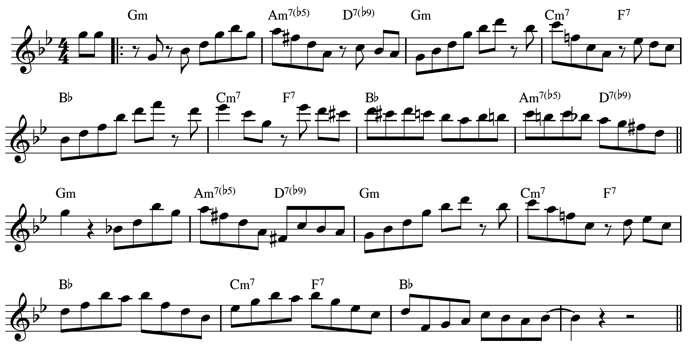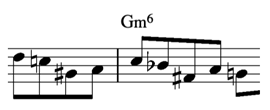How to Build Bebop Vocabulary – With Bach

This past March, on Bach’s 336th birthday, I put out a collection of jazz etudes called Bach Shapes: The Etudes. The book collects etudes from my Bach Shapes books, which isolate the beautiful melodic shapes of Bach’s music so you can apply them to tunes or technical practice. There are short analyses for each etude in the book but here I would like to go into a little more depth on one of them, something I’ve called “Love Me or Liebe Me.”
The Etude in a Jazz Quartet Setting
This etude started out as an improvisation on this line from Bach’s first Violin Partita:
 As written it lends itself pretty well to the changes of “Love Me or Leave Me.” So with that I was off to finishing the etude. First, I transposed the phrase from b minor to d minor and syncopated the melody to move it into 4/4 and give it some groove:
As written it lends itself pretty well to the changes of “Love Me or Leave Me.” So with that I was off to finishing the etude. First, I transposed the phrase from b minor to d minor and syncopated the melody to move it into 4/4 and give it some groove:
 Notice how the arpeggios spell out the chord tones of the Dm, then the dominant A7b9, Dm again, then the C7. We are leaving out the relative ii- chords, something which is always an option to us as improvisers. Bach’s melodies in minor keys often toggle between the tonic i- and the vii diminished, or V7b9. Charlie Parker does the same kind of thing on “Bebop”, which I’ve adapted here into another etude on “Indiana” in the book:
Notice how the arpeggios spell out the chord tones of the Dm, then the dominant A7b9, Dm again, then the C7. We are leaving out the relative ii- chords, something which is always an option to us as improvisers. Bach’s melodies in minor keys often toggle between the tonic i- and the vii diminished, or V7b9. Charlie Parker does the same kind of thing on “Bebop”, which I’ve adapted here into another etude on “Indiana” in the book:

Alternating here between Dm and C# diminished the whole time with some passing notes. I go into this line at more length in the upcoming Bach Shapes II. It’s important to see how minor tonalities really work. You’ll find that it’s not so much one scale: melodic minor, harmonic minor and natural minor; but all three of them adapting to the music as it goes along. Understanding when Bach, or Bird, uses the colors of each of those scales and why is an important concept that takes listening and practice.
At the end of the second A, there is a Bach pedal-point line:

In this case the “pedal-point” that we keep returning to is the F-E-F sequence at the top of the staff. While maintaining those notes, I voice lead from F Major to Gm7 and C7. You could take this concept through larger and larger chunks of a tune, changing notes as necessary to fit the chord changes. You would be working on voice leading, finding the closest available notes in the chord, which is an important concept to get into your ears and fingers. Notice how the above line is entirely diatonic to the F scale, but still interesting!
When we get to the bridge of the tune I break away into more bop oriented material:

Chromatic approach triplet to start it off, which gets me to the C, the 3 of the Am7b5, which I connect scale-wise to the third of the D7. In Bach and jazz, you’ll see many cases of connecting 3 to 7, or 7-3, our “guide tones.” This is followed by chromatic approach to the D, and then one of my favorite approaches:

Here I am approaching two notes, first the Bb, diatonically from above, then before getting there dropping two half steps below, up and over before resolving to the Bb, then followed by a quick melodic minor approach to the root, G. if you want to extend your lines, it’s all about exploring new twisty ways of chromatically approaching the chord tones. Check out Lee Konitz! I use this same approach to get to the A of the F chord in the next line.
Finally in the last A, I open up the original pattern, keeping that toggle from tonic to dominant that sounds so Bach-like:







Bach to Bebop: New Bach Shapes Article out for Best Sax Site Ever - Jon De Lucia Music
April 13, 2021 @ 3:12 pm
[…] I have a new article out today on the Best Saxophone Website Ever that analyzes one of the etudes from my book, Bach Shapes: The Etudes. Check it out! Pick up the […]